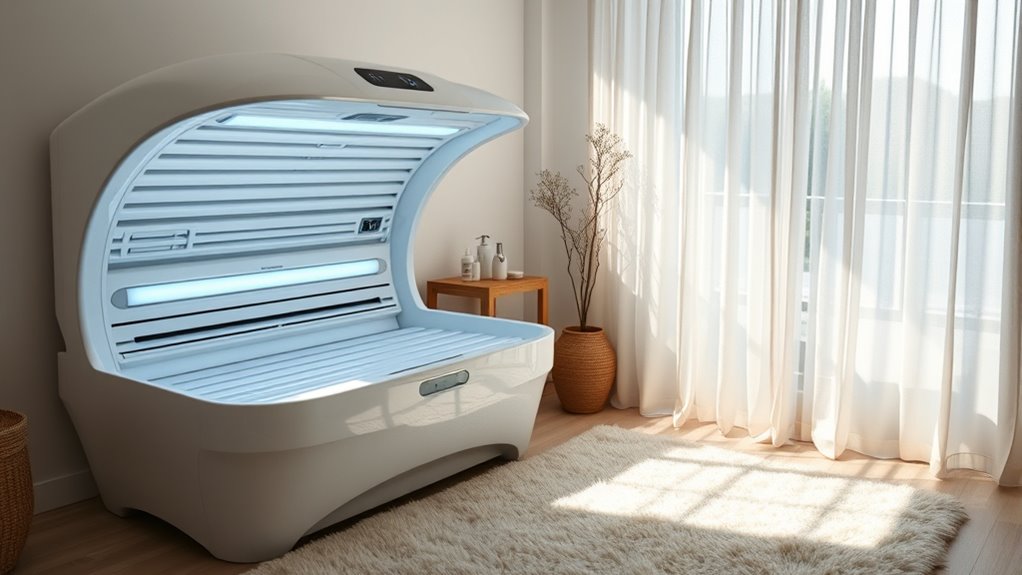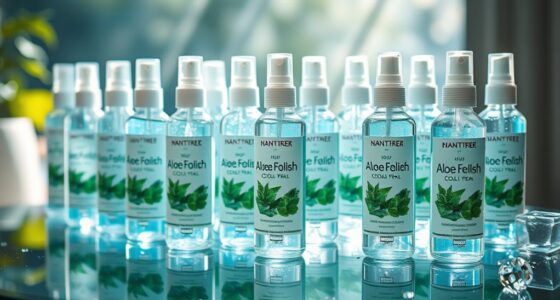To set up a home tanning space, choose a ground-floor area of about 100-150 sq ft with good ventilation, private access, and ceiling heights of 7-8 ft. Install moisture-resistant flooring and prioritize safety with proper lighting, ventilation, and durable equipment. Keep the space hygienic and compliant with legal standards, including age restrictions and proper waste disposal. If you continue, you’ll find detailed tips to create a safe, efficient, and comfortable tanning environment.
Key Takeaways
- Allocate a dedicated 100-150 sq ft private, ground-floor space with good ventilation, soundproofing, and ceiling height above 8 ft.
- Use moisture-resistant, slip-resistant flooring like vinyl or tiles for safety and hygiene.
- Install UVA/UVB tanning lamps with safety features, ensuring proper electrical setup and regular maintenance.
- Maintain strict hygiene protocols, disinfect equipment after each use, and keep safety manuals and emergency supplies accessible.
- Ensure compliance with local regulations, including age restrictions, licensing, proper waste disposal, and client education.
Choosing the Ideal Location for Your Tanning Area
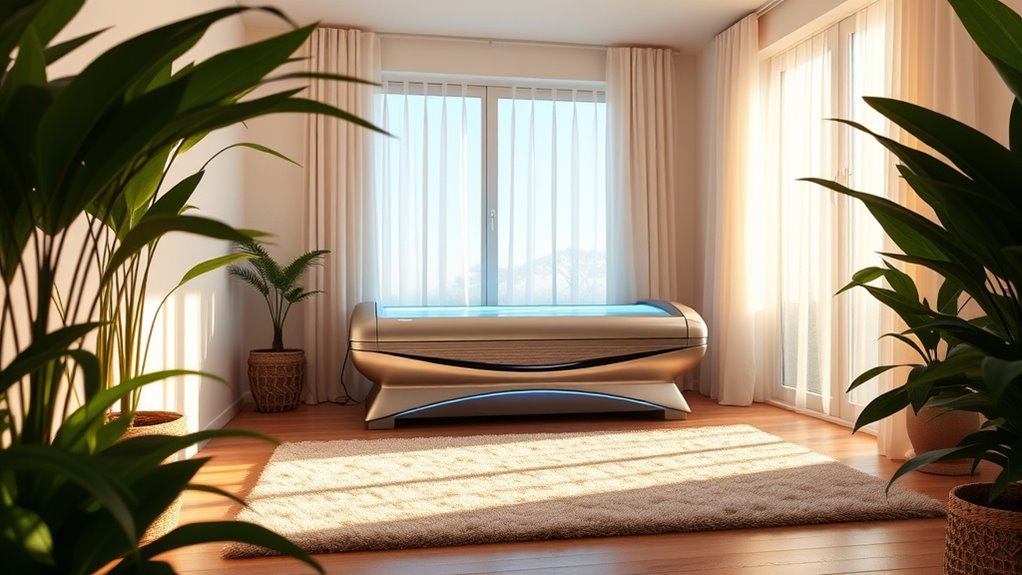
Selecting the right location for your home tanning space is crucial to guarantee safety, comfort, and efficiency. Aim for a space between 100-150 square feet to comfortably fit your tanning booth, storage, and client area. Avoid cramped layouts to allow free movement and quick equipment adjustments. Ensure the ceiling height is above 7-8 feet to accommodate vertical beds comfortably. Good ventilation is essential to prevent humidity buildup, especially if you offer spray tanning, and installing ventilation systems can significantly improve air quality. Proper electrical wiring is vital to ensure safety and compliance with electrical standards. Choose a ground-floor spot for easier equipment delivery and client access. Installing a private entrance helps minimize household disruptions. Incorporate soundproofing to reduce noise from fans or spray systems. Keep electrical circuits dedicated to your setup, and locate near a bathroom if offering spray services. Properly selecting your space lays the foundation for a safe, efficient tanning home. Additionally, considering building codes and permits ensures your setup complies with local regulations. When planning your space, it’s also beneficial to evaluate power requirements, particularly if you plan to use high-wattage equipment like tanning beds or spray booths.
Selecting and Installing Flooring and Wall Coverings
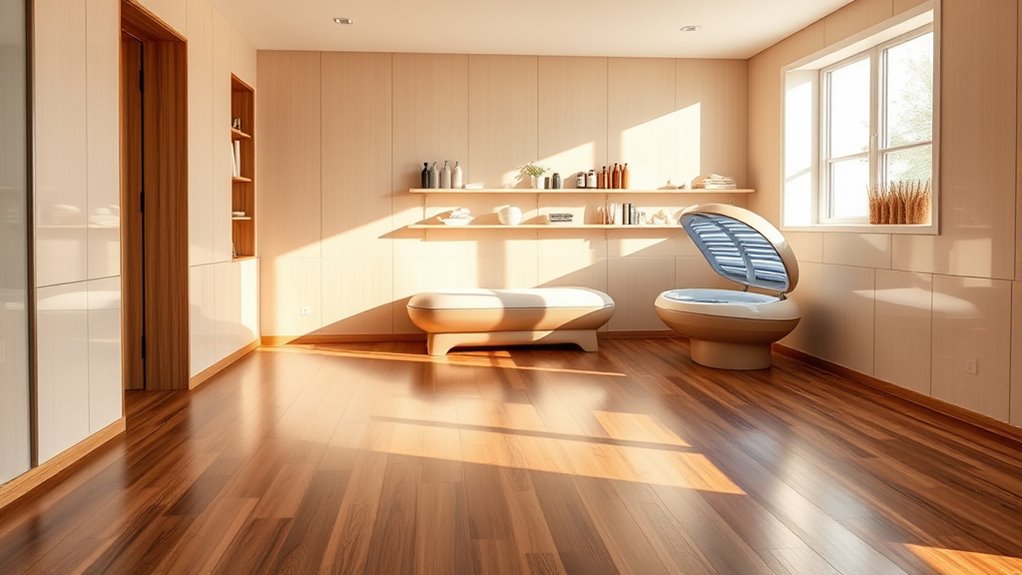
Choosing the right flooring and wall coverings is essential for creating a safe, durable, and easy-to-maintain home tanning space. For flooring, options like vinyl (VCT and LVT) offer style and versatility, while ceramic tiles provide durability and moisture resistance suited for high-traffic areas. EVA foam tiles, such as Wood Grain Foam Tiles, deliver cushioned comfort and are easy to clean, making them ideal for client comfort. Sport Plus Designer Foam Tiles are waterproof and anti-fatigue, perfect for spray tan setups. Concrete floors are durable but may need rugs for comfort. When installing, interlocking foam tiles are quick and simple, while ceramic tiles require professional setup. Choose materials that are non-porous, slip-resistant, and easy to disinfect to maintain hygiene and safety. Incorporating portable flooring options can also enhance flexibility for different setups and spaces, especially since material durability is crucial for long-term use. Additionally, selecting flooring that is easy to disinfect ensures a hygienic environment for clients and staff. It is also beneficial to consider best airless paint sprayers for maintenance or renovation projects to keep your space looking fresh and professional. To further support cleanliness and safety, selecting flooring with slip-resistant properties is highly recommended.
Ensuring Proper Lighting and Ventilation Systems
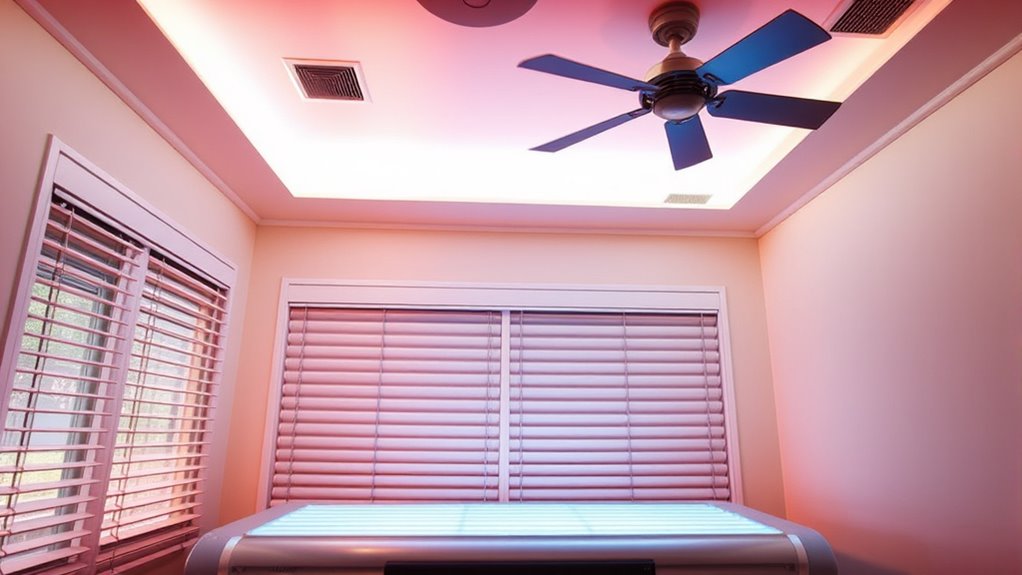
Proper lighting and ventilation are essential for creating a safe and comfortable home tanning space. You should choose tanning lamps with safety features like adjustable timers and auto-shutoff to prevent overexposure. Using UVA and UVB bulbs correctly is crucial for achieving a safe tan and avoiding skin damage. Consider options like portable sun lamps or multi-setting lamps that target different body areas for even results. LED technology offers efficient, customizable lighting with longer lifespans. Proper ventilation helps remove heat and odors, enhancing comfort and safety. You can opt for ceiling-mounted fans or dedicated ventilation systems tailored to your space. Quiet, energy-efficient systems are ideal, ensuring good airflow without disturbing your tanning sessions, creating a safe, pleasant environment. Additionally, understanding best anime movies can provide relaxing entertainment during your downtime. Incorporating proper maintenance practices into your setup can also extend the lifespan of your equipment and ensure consistent performance, especially if you utilize ventilation systems designed for continuous operation. Regular cleaning and inspection of your ventilation components help maintain optimal airflow and prolong system life. Ensuring that your ventilation system includes air quality monitoring can further improve safety by detecting any buildup of fumes or pollutants.
Setting Up Essential Tanning Equipment Safely
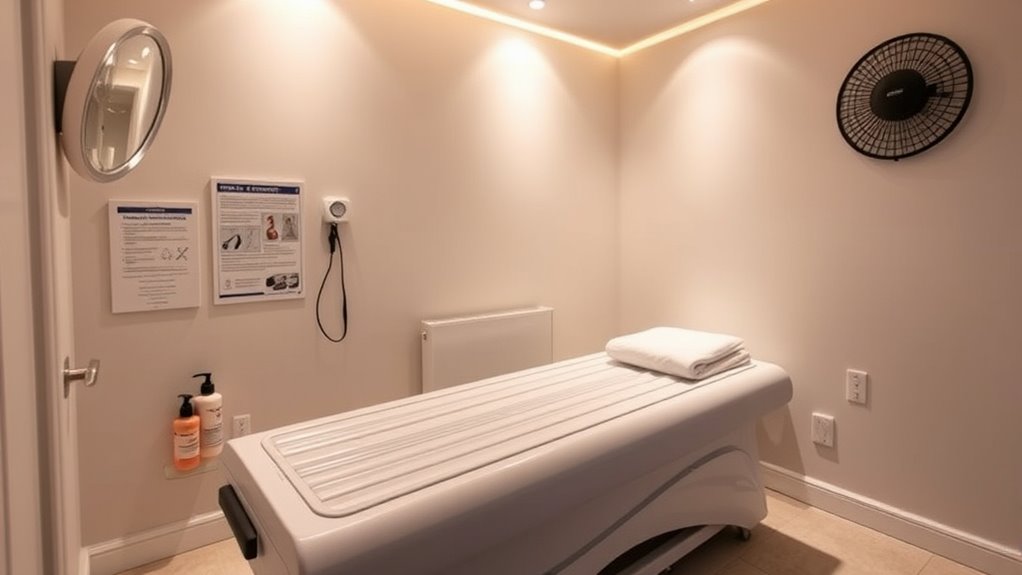
Setting up your essential tanning equipment safely starts with properly allocating space and ensuring that the area allows for smooth operation and movement. You need enough room for the equipment and to move comfortably around it. Check that the space has a stable power supply capable of handling the system’s requirements, especially if it has multiple settings or features. Use storage solutions like cup holders to keep tanning solutions within reach and organized. Position the equipment to allow for proper airflow, which helps reduce overspray and maintains safety. Make sure maintenance access is clear so you can easily perform regular upkeep. Following these steps minimizes hazards, keeps your space efficient, and guarantees your equipment functions correctly and safely during each tanning session. Additionally, ensuring your setup complies with legal information helps protect your rights and maintain safety standards. Considering proper ventilation is also crucial to ensure a safe and comfortable tanning environment. Incorporating fire safety measures can further reduce risks associated with electrical equipment and heat sources. Regularly inspecting your equipment for wear and tear helps prevent potential malfunctions and safety issues. To further enhance safety, installing appropriate fire extinguishers nearby can provide quick response in case of emergencies.
Implementing Safety Measures and Emergency Preparedness
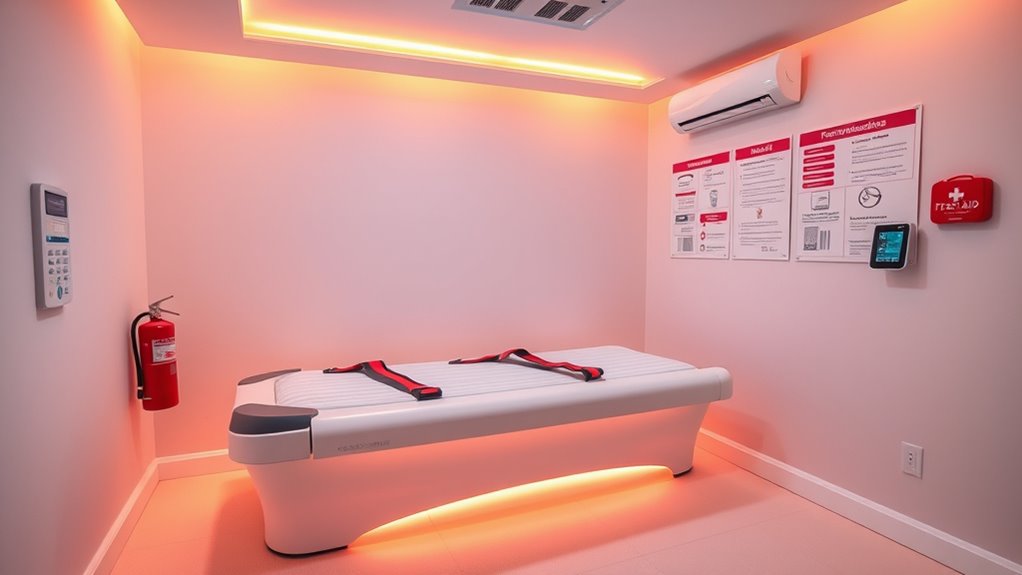
To guarantee your home tanning space remains safe, you need to implement essential safety measures and be prepared for emergencies. First, keep a well-stocked first aid kit nearby to address burns or injuries quickly. Install smoke detectors and ensure a fire extinguisher are accessible in the area. Regularly inspect tanning equipment for electrical damage or wear, and maintain detailed maintenance logs. Create a user safety manual that outlines emergency procedures and safety guidelines. Establish a clear medical emergency plan, including contacts and steps to follow if someone is injured. Ensure proper ventilation to prevent heat buildup, and supervise all users, especially beginners. Additionally, incorporating automation in safety monitoring can enhance real-time alerts and incident response. Developing proper safety protocols based on industry standards ensures consistent and effective safety practices. Being aware of air quality considerations and ensuring proper ventilation can significantly reduce health risks. Implementing regular safety training sessions for all users can further improve overall safety standards. It is also beneficial to keep updated with technological advances in safety equipment to continually improve your setup. By taking these precautions, you reduce risks and can respond swiftly in case of accidents, protecting yourself and others in your home tanning space.
Maintaining Hygiene and Regular Equipment Maintenance
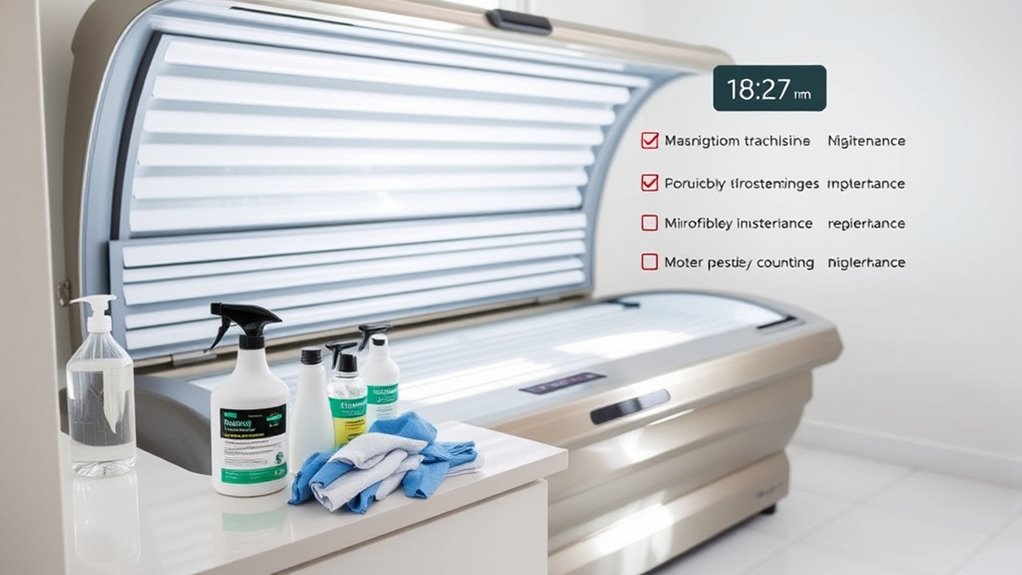
Maintaining hygiene and regular equipment maintenance are essential for a safe and effective home tanning space. You should clean your sunbed after each session to remove sweat and lotion, which can cloud the acrylic and reduce tanning results. Use a disinfectant spray, wait 60 seconds to kill germs, then wipe surfaces clean. Prepare disinfectant solutions fresh daily and test them with quat strips to ensure effectiveness. Regularly sanitize door handles, floors, and trash cans to prevent cross-contamination. Remove jewelry and avoid wearing studded clothing during sessions to prevent scratches, and use protective covers or towels on surfaces. Sanitize protective eyewear regularly, inspect acrylic surfaces for damage, and ensure equipment functions correctly. Proper hygiene and maintenance keep your tanning space safe, clean, and performing at its best.
Navigating Legal Requirements and Licensing
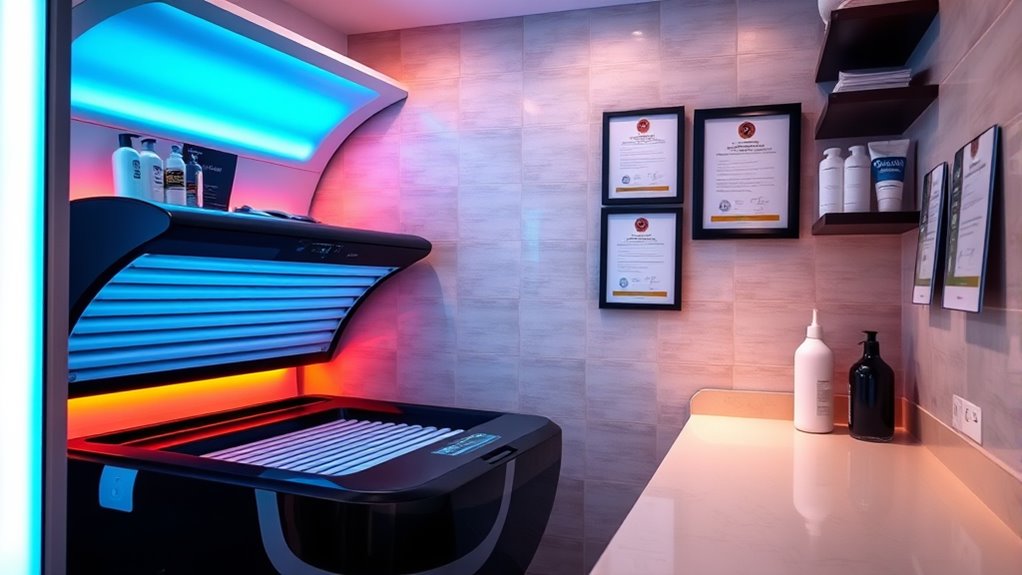
Understanding the legal landscape is key to running a safe and compliant home tanning setup. The FDA classifies tanning beds and sunlamps as Class II medical devices, meaning you’ll need to follow strict regulations, including proper labeling and safety standards. Since 2014, these devices are considered moderate risk, increasing oversight requirements. The FTC also monitors advertising practices to ensure honesty. Many states require you to register your tanning space annually, and some mandate a specific license before operation, with regular renewals and fees. Laws often prohibit minors under 18 from tanning, and verifying age with government IDs is essential. Regular inspections by health authorities guarantee compliance, and failing to meet these standards can lead to fines, closure, or legal action.
Preparing Clients and Providing Clear Usage Instructions
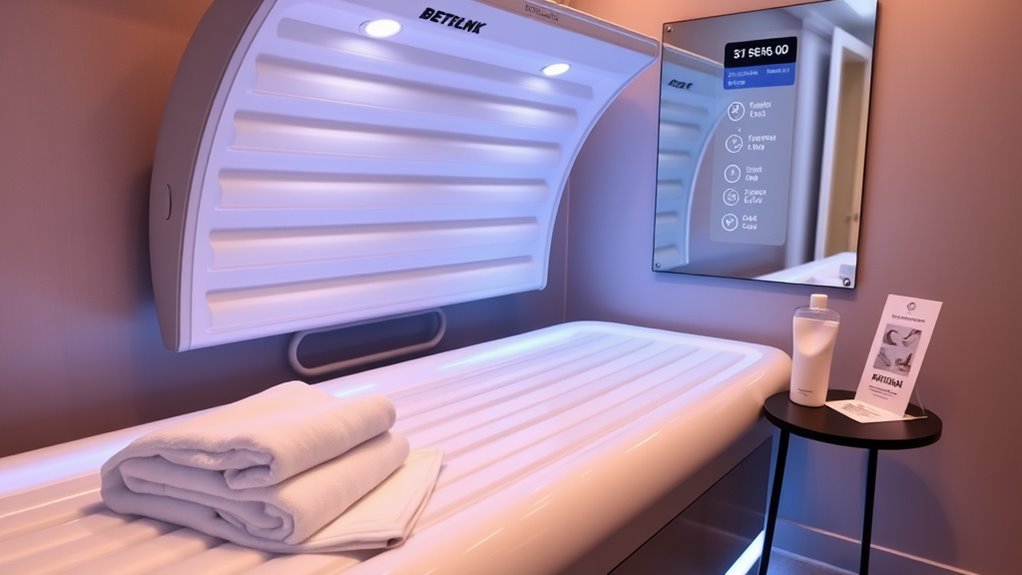
Are your clients fully prepared to get the best results from their tanning sessions? You need to guarantee they understand what to wear, what to avoid, and how to prepare their skin. Explain the importance of exfoliating beforehand for an even tan and suggest loose, dark clothing to prevent staining. Remind them to remove jewelry and avoid makeup and lotions on the day of the session. Educate clients on the need for privacy and comfort during their tanning experience, and encourage hydration before and during the session. After tanning, provide clear instructions on showering, moisturizing, and avoiding harsh products. Clear communication is key—send prep guidelines in advance, post them on your website, and be available for questions. This ensures clients are confident and well-informed, maximizing their results.
Managing Waste and Environmental Safety
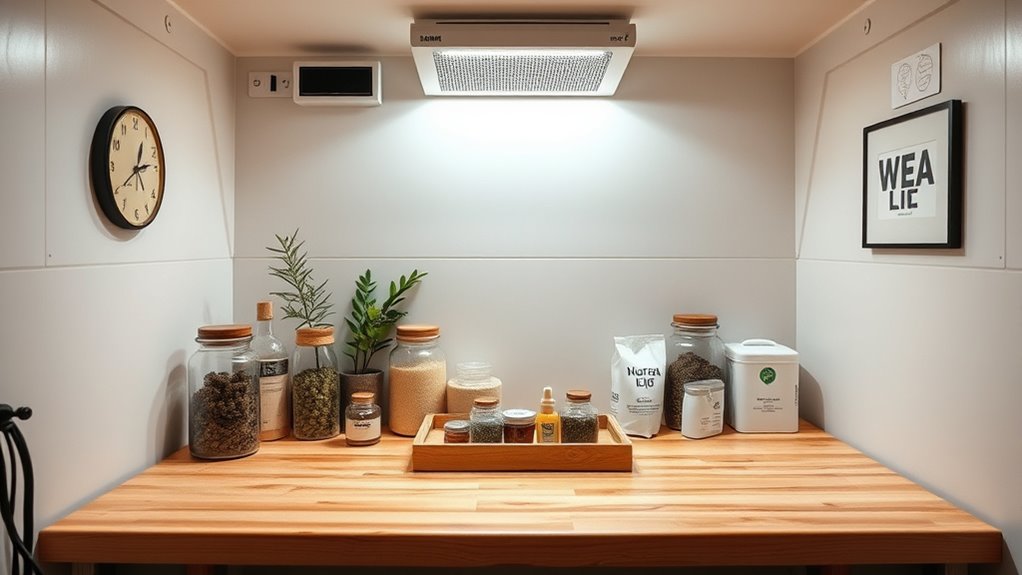
Managing waste and ensuring environmental safety are essential responsibilities when operating a home tanning space. Tanning beds contain hazardous materials like mercury and PCBs, requiring specialized disposal methods. UV lamps with mercury must be handled carefully and sent to hazardous waste facilities or recycling centers. Many states, such as California, mandate recycling of mercury-containing lamps, so it’s vital to follow local regulations. Proper disposal of these components prevents mercury contamination in air, soil, and water, protecting both the environment and public health. You can hire professional services like LoadUp for insured, eco-friendly removal and recycling. Always stay informed about regional laws and use local drop-off points or recycling programs for fluorescent tubes. Responsible waste management minimizes ecological impact and keeps your home tanning space compliant and safe.
Tips for Creating a Comfortable and Efficient Tanning Environment
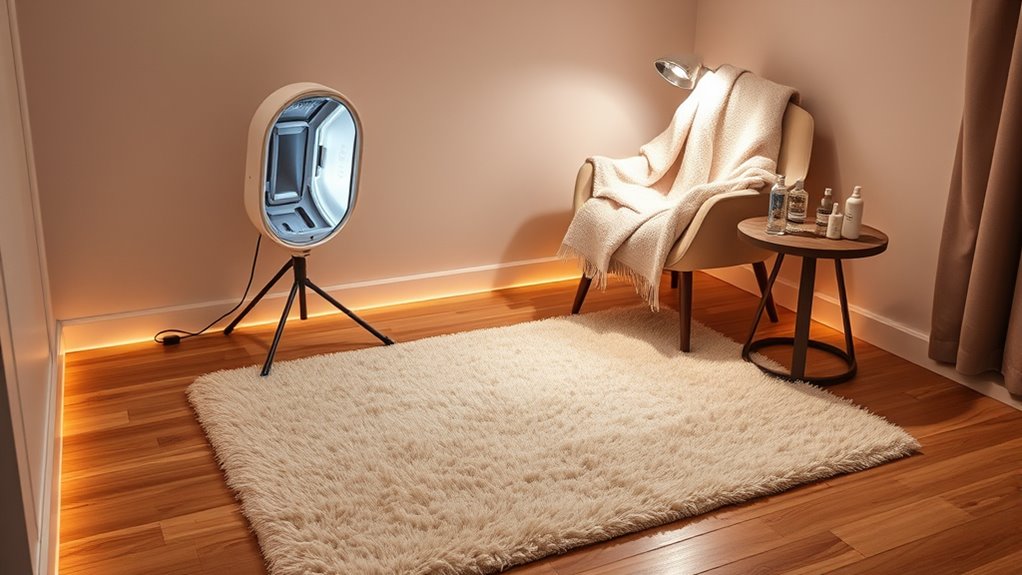
Creating a comfortable and efficient home tanning environment starts with thoughtful planning and attention to detail. Proper lighting sets the mood and ensures you can see your progress clearly. Good ventilation keeps the space fresh and safe, preventing stuffiness. Temperature control helps you relax, making sessions more enjoyable. Privacy is essential; use curtains or partitions to create a secluded area. Minimize noise by adding soft background music or soundproofing, boosting relaxation. Incorporate modern decor like sleek tanning beds and contemporary furniture to enhance the space’s look. Use floating cabinets and smart storage to stay organized and reduce clutter. Choosing calming color schemes and durable, easy-to-clean flooring further optimizes comfort and efficiency. These tips help create a space that’s both inviting and practical.
Frequently Asked Questions
How Can I Soundproof My Home Tanning Space?
To soundproof your space, start by sealing all gaps around doors, windows, and vents using acoustic sealant. Add heavy, solid doors and install soundproof curtains to block noise. Use acoustic panels and foam on walls to absorb sound, and place thick rugs or carpets on floors to reduce reflections. Combining these methods, you’ll minimize noise escape and create a quieter, more private environment for your tanning activities.
What Are the Best Ways to Control Humidity Levels?
Controlling humidity levels is key for a comfortable environment. You should use dehumidifiers to remove excess moisture and humidifiers to add it when needed. guarantee proper ventilation with fans or exhaust systems and monitor levels with a hygrometer. Adjust humidity gradually, and keep your space well-ventilated and free of excess water or overcrowding. Regularly maintain your equipment for consistent, ideal humidity control.
Which Safety Signs Should Be Displayed in the Area?
Imagine a lighthouse guiding ships safely ashore—that’s what safety signs do in your tanning area. You should display clear warnings about UV risks, FDA labels, and protective eyewear instructions. Post age restrictions, consent requirements, and emergency procedures. Mark equipment access and maintenance notices, and remind users about health hazards. These signs serve as your beacon, ensuring everyone understands the dangers and follows safety protocols for a secure tanning environment.
How Do I Prevent Overheating of Tanning Equipment?
To prevent overheating of tanning equipment, you should regularly check and maintain cooling systems like fans and air conditioning units. Guarantee ventilation is adequate and keep vents clear of dust or obstructions. Use preset programs to avoid overuse, and monitor equipment for unusual noises or heat. Proper maintenance, including lamp replacement and system inspections, helps keep temperatures in check, ensuring safe, efficient operation and extending your equipment’s lifespan.
What Options Are Available for Discreet Client Entry and Exit?
Think of your home as a secret garden, hidden from prying eyes. To keep client entry and exit discreet, create a designated, private entrance with a secure access code or keypad lock. Use screens or curtains to shield the area from view, and install soundproofing if possible. Encourage clients to arrive and leave quietly, ensuring their privacy remains as protected as a buried treasure.
Conclusion
Now that you’ve got the blueprint, setting up your home tanning space is as easy as pie—just don’t forget to follow safety protocols and respect legal guidelines. Keep your environment comfortable and well-ventilated, and remember, a tidy space is a happy space. With attention to detail, you’ll create a safe, efficient oasis that even Marie Antoinette would envy. So, roll up your sleeves and let your tanning sanctuary shine brighter than a diamond!
